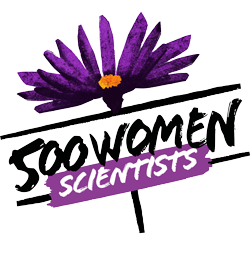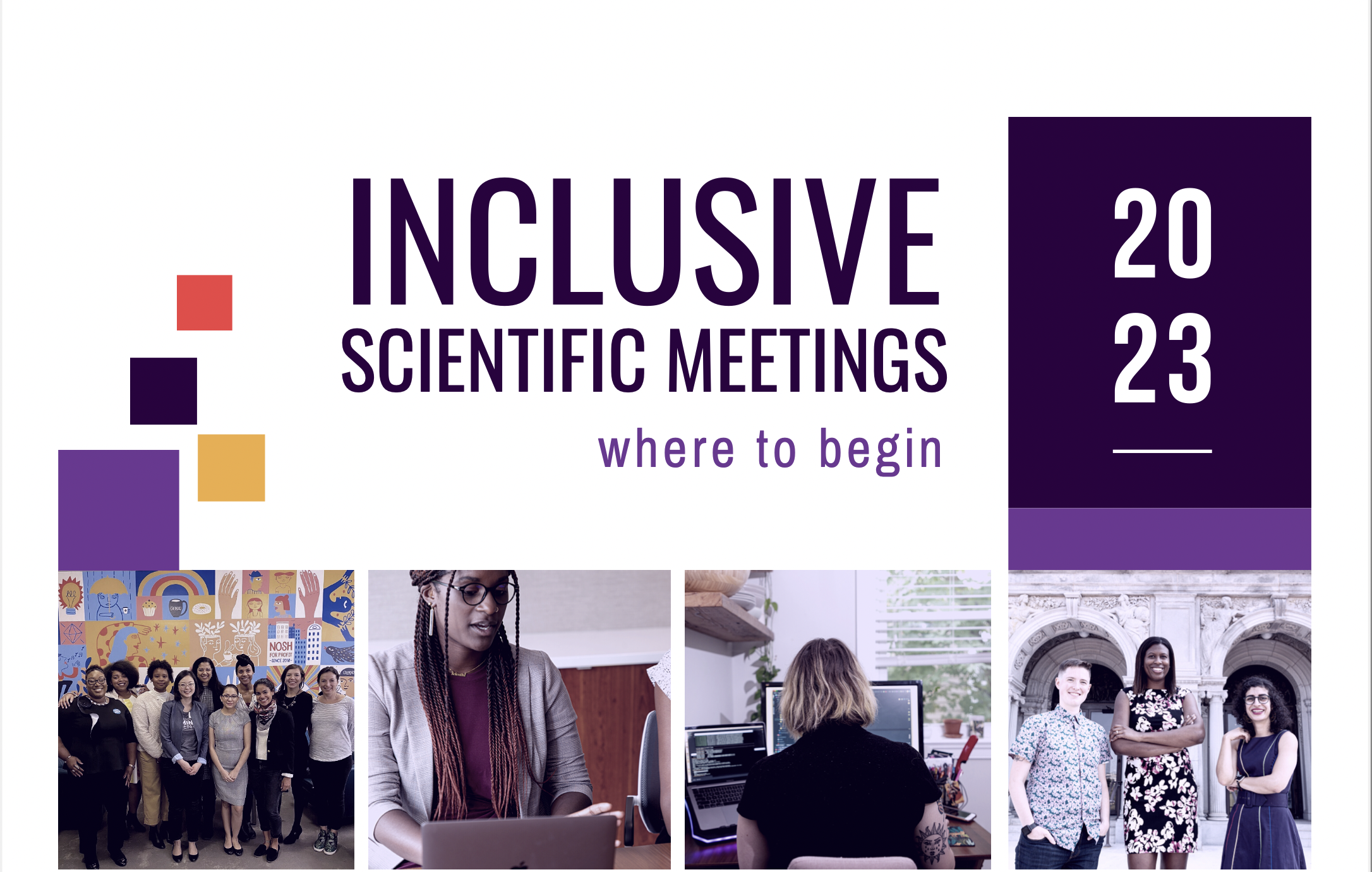500 Women Scientists. (n.d.). Fix the gender pay gap. [online] Available at: https:// 500womenscientists.org/fix-the-gap [Accessed 27 Oct. 2022].
American Association for Public Opinion Research, 2018. Best practices for survey research.
American Disability Act, 2009. Expanding your Market: Accessible Information Exchange Meeting on a Level Playing Field. [online] Available at: https://www.ada.gov/business/ accessiblemtg.htm [Accessed 28 Oct. 2022].
American Evaluation Association, 2011. Public Statement on Cultural Competence in Evaluation Public Statement on. (2011). [online] Available at: https://www.eval.org/Portals/0/Docs/ aea.cultural.competence.statement.pdf.
American Geophysical Union, 2017. AGU scientific integrity and professional ethics.
Anadu, J., Ali, H. and Jackson, C., 2020. Ten steps to protect BIPOC scholars in the field. Eos, 101(10.1029).
Arellano, E., 2020. Power Dynamics and Inclusion in Virtual Meetings. Aspiration Tech. Available at aspirationtech.org/files/AspirationPowerDynamicsAndInclusionInVirtualMeetings.pdf.
Atewologun, D. and Sealy, R., 2014. Experiencing privilege at ethnic, gender and senior intersections. Journal of Managerial Psychology, 29(4), doi: 10.1108/JMP-02-2013- 0038
Banaji, M.R. and Greenwald, A.G., 2013. Blindspot: Hidden biases of good people. Bantam. New York: Delacorte Press, 2013.
Barrett, J., 2020. The Ultimate Guide to Conference and Event Surveys. [online] Available at:
https://www.getfeedback.com/resources/online-surveys/ultimate-guide-conference- event-surveys/.
Barrows, A.S., Sukhai, M.A. and Coe, I.R., 2021. So, you want to host an inclusive and accessible conference?. FACETS, 6(1), pp.131-138.
Bates, K., Parker, C.S. and Ogden, C., 2018. Power Dynamics: The Hidden Element to Effective Meetings. Interaction Institute for Social Change, July, 11.
Bilimoria, D. and Liang, X., 2012. Gender equity in science and engineering: Advancing change in higher education. Routledge.
Campbell, L.G., Mehtani, S., Dozier, M.E. and Rinehart, J., 2013. Gender-heterogeneous working groups produce higher quality science. PloS one, 8(10), p.e79147.
CAST. 2019. About Universal Design for Learning. [online] Available at: https://www.cast.org/ impact/universal-design-for-learning-udl#.XEE6289KjOQ
Climate and Traditional Knowledges Workgroup (CTKW), 2014. Guidelines for Considering Traditional Knowledges (TKs) in Climate Change Initiatives. [online] Available at: https:// climatetkw.wordpress.com/
Concordats and agreements: their role in supporting effective research culture and working environments. 2022. [online] Universities UK. Available at: https:// www.universitiesuk.ac.uk/sites/default/files/field/downloads/2022-03/concordats- agreements-review_0.pdf.
Daniel, R., 2019. Understanding our environment requires an indigenous worldview. Eos, 100(10.1029).
Davenport, J.R., Fouesneau, M., Grand, E., Hagen, A., Poppenhaeger, K. and Watkins, L.L., 2014. Studying Gender in Conference Talks--data from the 223rd meeting of the American Astronomical Society. arXiv preprint arXiv:1403.3091.
Davis, L., 2020. 2018 Keynote: Dr. Lori Patton Davis. ASHE Office. Available at: https:// www.youtube.com/watch?v=B7zUFPKapzo.
De Picker, M., 2019. Rethinking inclusion and disability activism at academic conferences: strategies proposed by a PhD student with a physical disability. Disability & Society, pp.1–5. doi:10.1080/09687599.2019.1619234.
De Picker, M., 2020. Rethinking inclusion and disability activism at academic conferences: strategies proposed by a PhD student with a physical disability. Disability & Society, 35(1), pp.163-167.
Demery, A.J.C. and Pipkin, M.A., 2021. Safe fieldwork strategies for at-risk individuals, their supervisors and institutions. Nature Ecology & Evolution, 5(1), pp.5-9.
Demery, A.J. and Pipkin, M., 2020. Safe Fieldwork Strategies for At-Risk Individuals.
Drummond, C. and Fischhoff, B., 2017. Individuals with greater science literacy and education have more polarized beliefs on controversial science topics. Proceedings of the National Academy of Sciences, 114(36), pp.9587-9592.
51
Dutt, K. (n.d.). Evidence of Unconscious Bias -Best Practices and Guidelines for LDEO Search Committees. [online] Available at: https://diversity.ldeo.columbia.edu/sites/default/files/ content/Best%20Practices%20Bias%20Search%20Committees%20Mar2018%20.pdf.
Dutt, K., 2018. How implicit bias and lack of diversity undermine science. Scientific American. Ethics Forum. 2012. Ethics Forum» Full Text of the 2012 Ethics Statement. [online] Available at:
http://ethics.americananthro.org/category/statement/.
Ford, H.L., Brick, C., Azmitia, M., Blaufuss, K. and Dekens, P., 2019. Women from some under- represented minorities are given too few talks at world’s largest Earth-science conference.
Ford, H.L., Brick, C., Blaufuss, K. and Dekens, P.S., 2018. Gender inequity in speaking opportunities at the American Geophysical Union Fall Meeting. Nature communications, 9(1), pp.1-6.
Frassl, M.A., Hamilton, D.P., Denfeld, B.A., de Eyto, E., Hampton, S.E., Keller, P.S., Sharma, S., Lewis, A.S., Weyhenmeyer, G.A., O’Reilly, C.M. and Lofton, M.E., 2018. Ten simple rules for collaboratively writing a multi-authored paper. PLOS Computational Biology, 14(11), p.e1006508.
Freeman, R.B. and Huang, W., 2014. Collaborating with people like me: Ethnic co-authorship within the US (No. w19905). National Bureau of Economic Research.
Gay-Antaki, M. and Liverman, D., 2018. Climate for women in climate science: Women scientists and the Intergovernmental Panel on Climate Change. Proceedings of the National Academy of Sciences, 115(9), pp.2060-2065.
Gee, J. and Gee, J.P., 2007. Social linguistics and literacies: Ideology in discourses. Routledge. Gee, T., 2018. What Can Conferences Do To Attract More Women Speakers? [online] Trisha
Gee. Available at: https://trishagee.com/2018/04/20/more_women_speakers/. Glauber, K., Miller, B. & Hendren, C. O., 2020. Applying human-centered design to virtual
conference planning, s.l.: Integration and Implementation Insights.
Greene, S.E., Antell, G.S., Atterby, J., Bhatia, R., Dunne, E.M., Giles, S., Groh, S.S., Hanson, E.M., Hilton, J., Knight, H. and Kraftl, P., 2021. Safety and belonging in the field: a checklist for educators.
Haugh, D. (n.d.). Yale University Library Research Guides: Academic Poster Resources: Accessibility. [online] guides.library.yale.edu. Available at: https://guides.library.yale.edu/ academic-poster-resources/accessibility.
IACC Guide to Dietary Requirements. (n.d.) [Online] Available at: https://www.iacconline.org/ guide-meeting-delegates-dietary-requirements
Jimenez, M.F., Laverty, T.M., Bombaci, S.P., Wilkins, K., Bennett, D.E. and Pejchar, L., 2019. Underrepresented faculty play a disproportionate role in advancing diversity and inclusion. Nature ecology & evolution, 3(7), pp.1030-1033.
Jones, T.M., Fanson, K.V., Lanfear, R., Symonds, M.R. and Higgie, M., 2014. Gender differences in conference presentations: a consequence of self-selection?. PeerJ, 2, p.e627.
Kappel, E.S. and Thompson, L., 2014. Invited Scientific Papers and Speakers and Fellow Awardees Little Progress for Women Oceanographers in the Last Decade. Oceanography, 27(4), pp.24-28.
Kazil, J., 2017. Best Practices for Lactations Spaces for Event Organizers. [online] Medium. Available at: https://medium.com/@jackiekazil/best-practices-for-lactations-spaces-for- event-organizers-8b6c77797c45 [Accessed 27 Oct. 2022].
King, N.S. and Pringle, R.M., 2019. Black girls speak STEM: Counterstories of informal and formal learning experiences. Journal of Research in Science Teaching, 56(5), pp.539-569.
Kozlowski, D., Larivière, V., Sugimoto, C.R. and Monroe-White, T., 2022. Intersectional inequalities in science. Proceedings of the National Academy of Sciences, 119(2), p.e2113067119.
Lauer, A. (2020). Cyberinfrastructure professionals' withdrawal cognitions: An exploration of race, gender, and occupational climate in high performance computing. Doctoral dissertation, Creighton University. http://hdl.handle.net/10504/129478
leanin.org. 2020. The State of Black Women in Corporate America. [online] Available at: https:// leanin.org/research/state-of-black-women-in-corporate-america.
Legalities of Sexual Harassment in the Workplace: A Q&A Session with Our Online MJ-LEL Program Director. 2020. Tulane Online Law Blog. Available at: https:// online.law.tulane.edu/blog/legal-truths-sexual-harassment.
Loder, N., 1999. Gender discrimination ‘undermines science’. Nature, 402(6760), pp.337-337.
Malcom, S. and Feder, M., editors. Barriers and Opportunities for 2-Year and 4-Year STEM Degrees: Systemic Change to Support Students' Diverse Pathways. Washington (DC): National Academies Press (US); 2016 May 18. 3, The Culture of Undergraduate STEM Education.
Marín-Spiotta, E., Barnes, R.T., Berhe, A.A., Hastings, M.G., Mattheis, A., Schneider, B. and Williams, B.M., 2020. Hostile climates are barriers to diversifying the geosciences. Advances in Geosciences, 53, pp.117-127.
McGuire, W., 2020. Labor Acknowledgement In Advance Of Black History Month. Available at: https://www.youtube.com/watch?v=bu4maCxPCOk.
McLeod PL, Lobel SA, Cox TH. Ethnic Diversity and Creativity in Small Groups. Small Group Research. 1996; 27(2):248-264. doi:10.1177/1046496496272003
MeetingPlay, 2020. 17 Questions to Ask in Your Virtual Post-Event Survey. [Online] Available at: https://www.meetingplay.com/blog/17-questions-to-ask-in-your-virtual-post-event-survey.
Michaels, S. and O’Connor, C., 2012. Talk science primer. Cambridge, MA: TERC.
Missouri Statediversity.missouristate.edu. (n.d.). Cultural and Religious Observances - Diversity, Equity and Inclusion - Missouri State. [online] Available at: https:// diversity.missouristate.edu/Observances.htm.
National Science Board, 2015. Revisiting the STEM workforce: A companion to science and engineering indicators 2014. Arlington.
Native Governance Center, 2019. A guide to Indigenous land acknowledgment. [online] Native Governance Center. Available at: https://nativegov.org/news/a-guide-to-indigenous-land- acknowledgment/.
Native Land Digital, 2019a. NativeLand.ca. [online] Native-land.ca - Our home on native land. Available at: https://native-land.ca/.
Native Land Digital, 2019b. Territory Acknowledgement. [online] Available at: https://native- land.ca/resources/territory-acknowledgement/.
Nederveld, A. and Berge, Z.L., 2015, "Flipped learning in the workplace", Journal of Workplace Learning, Vol. 27 No. 2, pp. 162-172.
Nielsen, M.W., Alegria, S., Börjeson, L., Etzkowitz, H., Falk-Krzesinski, H.J., Joshi, A., Leahey, E., Smith-Doerr, L., Woolley, A.W. and Schiebinger, L., 2017. Gender diversity leads to better science. Proceedings of the National Academy of Sciences, 114(8), pp.1740-1742.
Office of Disability Employment Policy. 2019 www.dol.gov. (n.d.). Universal Design Resources | U.S. Department of Labor. [online] Available at: https://www.dol.gov/agencies/odep/ program-areas/employment-supports/universal-design/resources [Accessed 27 Oct. 2022].
Paul, 2021. Why You Should Take Meeting Breaks. meetric. Available at: https:// www.meetric.app/blog/why-you-should-take-meeting-breaks.
Paul, 2022. The Zoom Fatigue Is Real - Fix It. meetric. Available at: https://www.meetric.app/ blog/the-zoom-fatigue-is-real-fix-it.
Perkins School for the Blind. (n.d.). Make your meeting accessible. [online] Available at: https:// www.perkins.org/resource/make-your-meeting-accessible/ [Accessed 28 Oct. 2022].
Reparations 4 Slavery. (n.d.). Acknowledgement. [online] Available at: https:// reparations4slavery.com/acknowledgement/.
Responsible and Ethical Conduct of Research (RECR) | NSF - National Science Foundation. [online] Available at: https://www.nsf.gov/od/recr.jsp.
Sardelis, S. and Drew, J.A., 2016. Not “pulling up the ladder”: women who organize conference symposia provide greater opportunities for women to speak at conservation conferences. PloS one, 11(7), p.e0160015.
Schroeder, J., Dugdale, H.L., Radersma, R., Hinsch, M., Buehler, D.M., Saul, J., Porter, L., Liker, A., De Cauwer, I., Johnson, P.J. and Santure, A.W., 2013. Fewer invited talks by women in evolutionary biology symposia. Journal of evolutionary biology, 26(9), pp.2063-2069.
Seeds for Change. 2011. Consensus Decision Making - Seeds for Change. [online] Available at: https://www.seedsforchange.org.uk/consensus.
Seeds for Change. (n.d.). A short guide to Facilitating Meetings. [online] Available at: https:// www.seedsforchange.org.uk/shortfacilitation.
Serrato Marks, G., 2018. How to make professional conferences more accessible for disabled people: guidance from actual disabled scientists. Union of Concerned Scientists Blog: The Equation, 8. [online] Available at: https://blog.ucsusa.org/science-blogger/how-to- make-professional-conferences-more-accessible-for-disabled-people-guidance-from- actual-disabled-scientists/.
Small, A., 2020. Land Acknowledgments Accomplish Little. inside higher ed. [online] 9 Jan. Available at: https://www.insidehighered.com/views/2020/01/09/why-land- acknowledgments-arent-worth-much-opinion.
Southwest Network for Environmental and Economic Justice, 1996. Jemez Principles for Democratic Organizing.
SpeedNetworking.com, 2019. The Value of Face to Face Meetings: Why In-Person Is Better Than Online. [online] Medium. Available at: https://medium.com/@shannonkelly_80469/ the-value-of-face-to-face-meetings-why-in-person-is-better-than-online-14db4d3bea7f.
Steele, C.M., 2011. Whistling Vivaldi: How stereotypes affect us and what we can do. WW Norton & Company.
Stewart, T. ’TJ’, 2021. On Labor Acknowledgements and Honoring the Sacrifice of Black Americans. Diverse: Issues In Higher Education. Available at: https:// www.diverseeducation.com/demographics/african-american/article/15108677/on-labor- acknowledgements-and-honoring-the-sacrifice-of-black-americans.
Sufi, S., Nenadic, A., Silva, R., Duckles, B., Simera, I., de Beyer, J.A., Struthers, C., Nurmikko- Fuller, T., Bellis, L., Miah, W. and Wilde, A., 2018. Ten simple rules for measuring the impact of workshops. PLOS Computational Biology, 14(8), p.e1006191.
Timmer, A., Sutherland, L.R. and Hilsden, R.J., 2003. Development and evaluation of a quality score for abstracts. BMC medical research methodology, 3(1), pp.1-7.
Trewin, S., Hanson, V., Rode, J., Mankoff, J., Brady, E., Morris, M.R. and Hwang, F., 2019. Accessible Conference Guide. ACCESS: Special Interest Group on Accessible Computing. [online] Available at: http://www.sigaccess.org/welcome-to-sigaccess/ resources/accessible-conference-guide/ [Accessed 28 Oct. 2022].
University of Michigan. (n.d.). Personally Identifiable Information (PII) / Sensitive Data Guide. [online] Available at: https://safecomputing.umich.edu/dataguide/?q=node/89.
University of Minnesota, Accessible U (n.d.). Slide Presentations | Accessible U. [online] Available at: https://accessibility.umn.edu/what-you-can-do/create-accessible-content/ slide-presentations.
Web Accessibility Initiative (WAI), W.W.A. (n.d.). How to Make Your Presentations Accessible to All. [online] Web Accessibility Initiative (WAI). Available at: https://www.w3.org/WAI/ teach-advocate/accessible-presentations/.
Xu, Y.J. and Martin, C.L., 2011. Gender differences in STEM disciplines: From the aspects of informal professional networking and faculty career development. Gender Issues, 28(3), pp.134-154.
Yee, M., 2019. Why ‘safe spaces’ are important for mental health—especially on college campuses.










